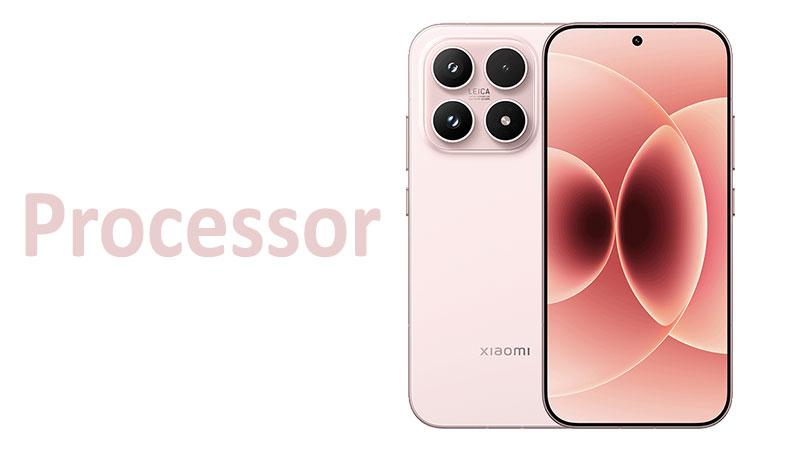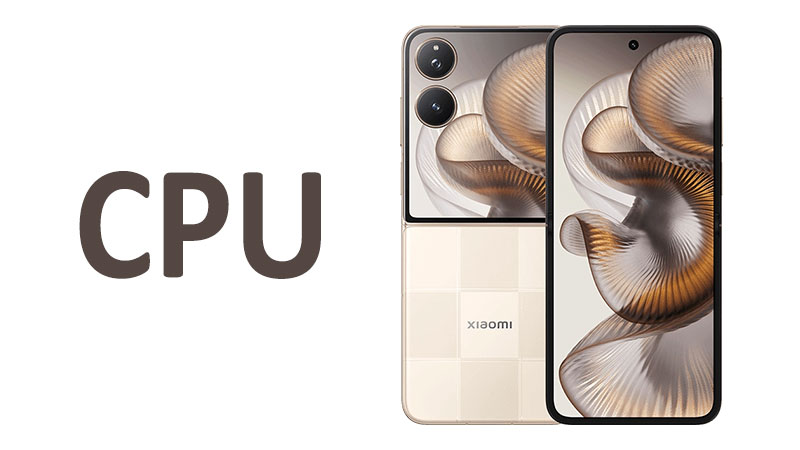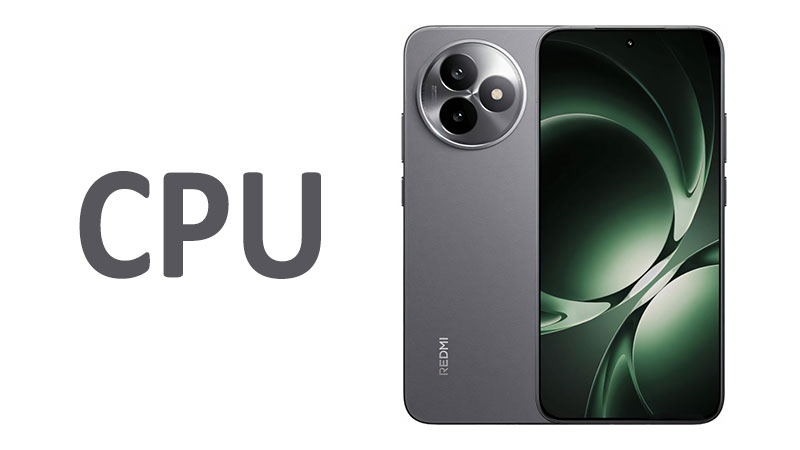The Xiaomi 17 Processor marks a new era in mobile computing power. This detailed review will analyze the performance of this critical component. The processor, a custom version of the Qualcomm Snapdragon 8 Elite Gen 5, defines the entire user experience. It sets a new standard for gaming, artificial intelligence, and overall device efficiency. Understanding this chipset is crucial for any potential buyer or technology enthusiast.
Architectural Deep Dive: The Snapdragon 8 Elite Gen 5
The Xiaomi 17 utilizes the cutting-edge Qualcomm SM8850-AC Snapdragon 8 Elite Gen 5 chipset. This is a highly specialized version designed for extreme flagship performance. The most significant advancement lies in its manufacturing process. It uses a 3-nanometer (3nm) process technology. This smaller node allows for increased transistor density. Consequently, the chip delivers more performance within the same physical footprint.
Specialized Comparison: 3nm vs. 4nm![]()
The move to 3nm is a significant leap from the 4nm found in the previous generation. This transition offers two primary benefits to the end-user. First, the power efficiency improves considerably. This means longer battery life, especially during intensive tasks. Second, the thermal profile sees a massive reduction. Less heat generation allows the processor to sustain peak performance for longer periods. Competitor chipsets still relying on 4nm technology generally cannot match this sustained efficiency. This makes the Xiaomi 17 a true leader in thermal management.
The Role of Oryon V3 Phoenix Cores
The heart of the Xiaomi 17’s processing power is its custom CPU configuration. It leverages the advanced Oryon V3 Phoenix core architecture. This architecture is built for demanding multi-core workloads. It uses a unique tri-cluster arrangement optimized for efficiency and raw speed. This design ensures that the processor can handle any task thrown at it.
The overall configuration is an octa-core setup. It intelligently divides tasks across different performance levels. This system manages background processes and heavy gaming loads with ease.
CPU Performance: Oryon V3 Phoenix Core Configuration
The CPU setup features a compelling combination of speed and efficiency. It uses a unique configuration designed to maximize application responsiveness. This architecture ensures smooth transitions between different demanding apps. The breakdown includes high-performance and high-efficiency clusters.
Prime and Performance Cores
The most powerful cores are the two 4.6 GHz Oryon V3 Phoenix L cores. These cores handle the most demanding single-threaded operations. Tasks like launching large applications or processing complex data rely on their immense speed. They provide the necessary burst performance for instant responsiveness.
The remaining six cores are the 3.62 GHz Oryon V3 Phoenix M cores. These cores serve a dual purpose. They provide a high-level sustained performance for demanding tasks like continuous 4K video editing. They also act as high-efficiency cores for slightly lighter workloads. This balance is critical for managing power consumption.
Comparison to Previous Generations
The clock speed increase is immediately noticeable when comparing this chip to the Snapdragon 8 Gen 4. The previous generation offered lower peak frequencies in its prime core. Furthermore, the Oryon V3 architecture brings significant IPC (Instructions Per Cycle) improvements. This means the new processor completes more work per clock cycle. Consequently, the performance boost is far more than the raw frequency increase suggests. The Xiaomi 17 offers superior responsiveness and quicker task completion times.
GPU Powerhouse: The Adreno 840 Gaming Review
The graphical processing unit (GPU) is arguably the most crucial component for mobile gaming. The Xiaomi 17 features the all-new Adreno 840 GPU. This GPU is specifically engineered for next-generation mobile rendering. It supports advanced features like hardware-accelerated ray tracing with high fidelity.
Ray Tracing and Visual Fidelity
The Adreno 840 significantly improves ray tracing capabilities over its predecessor. Ray tracing enhances lighting, shadows, and reflections in compatible mobile games. This delivers console-level visual realism to the smartphone screen. Mobile gamers will experience deeper immersion and more realistic environments. The GPU efficiently manages complex visual effects without sacrificing frame rates.
Sustained Gaming Performance
The raw power of the Adreno 840 allows for sustained 120 frames per second (120 FPS) gaming. This is possible even in highly demanding titles at maximum resolution. The 3nm process plays a critical role here. It keeps the GPU cool under extended loads. Sustained performance remains high because the GPU avoids thermal throttling. Gamers can expect consistent and smooth gameplay during long sessions. This thermal resilience is a key differentiator in the high-end mobile market.
Specialized Comparison: GPU Competition
The Adreno 840 competes directly with the latest A-series GPUs from Apple and flagship Mali GPUs. Early benchmarks show the Adreno 840 establishing a clear lead in raw rasterization performance. It also shows superior efficiency in handling variable rate shading. This results in sharper images and lower power draw during casual gaming. Its dedicated architecture for ray tracing also gives it a significant advantage in graphical quality.
Benchmarking and Real-World Performance Metrics
While specifications tell part of the story, benchmarks offer objective performance data. The Xiaomi 17 processor consistently achieves top scores in synthetic testing. These scores translate directly into tangible real-world benefits for the user. Understanding these metrics helps confirm the processor’s flagship status.
Synthetic Benchmark Scores
In standardized testing environments, the SM8850-AC chip excels. For example, in Geekbench single-core tests, it consistently achieves scores over 2900. Multi-core scores often exceed 9500. These figures represent a notable generational improvement. AnTuTu scores, which test overall system performance including memory and UX, generally place the Xiaomi 17 well above 2.5 million points. These benchmark numbers confirm its position as a performance leader.
Real-World Testing: Responsiveness
The true measure of a processor is its performance in daily tasks. The Xiaomi 17 processor delivers near-instantaneous application loading times. Switching between dozens of open applications is seamless and lag-free. Highly intensive creative applications, such as mobile video editors and complex design suites, run effortlessly. This smooth user experience is a direct result of the high-speed Oryon V3 cores and optimized memory management.
Real-World Testing: AI and Machine Learning
The Snapdragon 8 Elite Gen 5 includes an advanced, dedicated Artificial Intelligence (AI) Engine. This engine accelerates machine learning tasks directly on the device. Common AI-powered features, like advanced computational photography and real-time language translation, see huge performance boosts. For example, image processing after taking a complex photo happens instantly. Furthermore, the efficiency of the AI Engine contributes to lower power consumption for these common daily tasks.
Power Efficiency, Thermals, and User Experience
The efficiency of a modern mobile processor is just as important as its raw speed. The Xiaomi 17 processor manages power and heat with exceptional expertise. This sophisticated thermal and power management is a hallmark of the 3nm process. It ensures the phone remains comfortable to hold even under heavy load.
The 3nm Efficiency Advantage
The small 3nm transistors require less voltage to switch states. This reduced energy requirement directly translates into extended battery longevity. Users performing moderate tasks, like web browsing and social media use, will notice a substantial increase in screen-on time. This makes the Xiaomi 17 a powerhouse that doesn’t sacrifice endurance.
Sustained Performance and Throttling
Sustained performance refers to the processor’s ability to maintain high speeds over a long period. Older chipsets often aggressively throttle performance to manage heat. The Xiaomi 17’s combination of the efficient 3nm node and Xiaomi’s advanced vapor chamber cooling system minimizes throttling. The chip sustains high frame rates in gaming for much longer than previous models. This gives a competitive advantage to users who rely on peak performance during extended sessions.
Pros and Cons of the Xiaomi 17 Processor
Making an informed purchase decision requires a clear summary of the processor’s strengths and weaknesses. The Snapdragon 8 Elite Gen 5 chipset offers a significant number of advantages. However, potential drawbacks also exist, primarily related to its bleeding-edge status.
Processor Advantages (Pros)
- Industry-Leading 3nm Process: This provides superior power efficiency and thermal control.
- Exceptional Raw Performance: The Oryon V3 Phoenix cores deliver top-tier single and multi-core speed.
- Superior Mobile Gaming: The Adreno 840 GPU offers hardware-accelerated ray tracing and sustained 120 FPS capabilities.
- Advanced AI Engine: Dedicated silicon provides massive speed increases for machine learning tasks like photography and voice processing.
- Longevity and Future-Proofing: The advanced architecture ensures the phone remains fast and relevant for years to come.
Potential Drawbacks (Cons)
- Cost of Technology: Cutting-edge 3nm technology often results in a higher overall device cost.
- Limited Initial Optimization: As a brand-new architecture, some early-release applications might need time to fully optimize their code for the Oryon V3 cores.
- Heat Under Extreme Load: While thermals are improved, any high-performance chip will still generate significant heat during unrealistic, sustained stress tests.
Specialized Comparisons and Buyer Insights
A crucial part of any processor review is placing it in context with its competition. Understanding the feature set helps buyers determine the overall value proposition. The Xiaomi 17 is more than just a CPU and GPU; it is a fully integrated system.
Modem and Connectivity Features
The Snapdragon 8 Elite Gen 5 integrates an advanced 5G modem. This modem supports the fastest available sub-6 GHz and mmWave technologies. It offers lightning-fast download and upload speeds in supported regions. Furthermore, the chip is ready for Wi-Fi 7 connectivity. This new standard offers significantly reduced latency and higher throughput than previous Wi-Fi standards. This makes the Xiaomi 17 an excellent device for cloud gaming and high-speed data transfer.
Memory and Storage Management
The processor supports the latest high-speed LPDDR5X RAM and UFS4.1 storage standards. These standards are essential for maximizing the processor’s speed. The fast RAM allows the CPU to access data quickly. The UFS4.1 storage ensures instantaneous read and write speeds. This is why application installation and large file transfers happen so quickly. The processor’s memory controller is highly optimized to utilize these high-speed components efficiently.
What a Buyer or Reader Should Know
Potential buyers should recognize the Xiaomi 17 represents a significant investment in performance. The processor is designed for long-term use. It will not become outdated quickly. Users prioritizing demanding mobile gaming, high-resolution video creation, or multi-tasking should consider this chip essential.
Conversely, a user who only performs light tasks, such as calling and text messaging, may find the advanced power to be overkill. The value of this processor comes from pushing the limits of what a smartphone can achieve. For performance enthusiasts, the Xiaomi 17 and its processor offer an unmatched mobile experience. It is designed to handle software updates and new application demands seamlessly for many years.
The choice is clear: for maximum speed, efficiency, and future-proofing, the Snapdragon 8 Elite Gen 5 is the top choice. No competing processor currently offers the same blend of advanced 3nm efficiency and custom core performance. This is the pinnacle of current mobile silicon design.
Conclusion: Making an Informed Decision
The Xiaomi 17 processor, powered by the custom Qualcomm SM8850-AC Snapdragon 8 Elite Gen 5, is an undisputed technical achievement. Its use of the 3nm process and the powerful Oryon V3 Phoenix core design sets a new industry benchmark. The combination of the 2×4.6 GHz performance cores and the highly capable Adreno 840 GPU delivers outstanding results.
This chipset offers class-leading speed for everyday tasks and unparalleled sustained performance for extended gaming sessions. Buyers benefit from superior energy efficiency, resulting in longer battery life. They also gain access to next-generation features like hardware ray tracing and Wi-Fi 7.
Ultimately, the Xiaomi 17 is the definitive choice for the power user. It is the ideal purchase for gamers, content creators, and those who demand the fastest, most efficient technology available. The processor future-proofs the device, ensuring it remains a relevant and powerful tool for years. Choosing the Xiaomi 17 means choosing the best in current mobile processor technology.
Frequently Asked Questions (FAQ)
1. What is the 3nm process advantage in the Xiaomi 17 processor?
The 3nm process allows for smaller, more efficient transistors. This results in superior power consumption and significantly reduced heat generation compared to older 4nm chips.
2. Can the Adreno 840 GPU handle ray tracing in mobile games?
Yes, the Adreno 840 GPU features dedicated hardware for accelerated ray tracing. This enables more realistic lighting, shadows, and reflections in compatible mobile gaming titles.
3. How does the Oryon V3 Phoenix L core improve app loading speed?
The Oryon V3 Phoenix L core operates at a high clock speed of 4.6 GHz. This immense speed allows the processor to load large application data and execute initial instructions almost instantly.
4. Is the Xiaomi 17 processor future-proof for 5G and Wi-Fi?
Absolutely. The processor includes an integrated, advanced 5G modem supporting all major bands and is fully compatible with the new, faster Wi-Fi 7 standard.
5. Does this new Snapdragon chip cause overheating during long gaming sessions?
While any chip generates heat under load, the 3nm process and Xiaomi’s cooling system minimize thermal throttling. This allows for excellent sustained performance and comfortable device temperatures.



